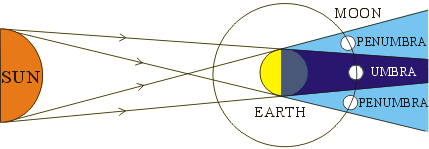Lunar Eclipse
The cause of Lunar EclipseThe earth throws a long shadow behind the side facing the sun. A lunar eclipse occurs when the moon enters the earth's shadow. This shadow has two parts: the total shadow called the umbra and the partial shadow termed the penumbra. (See Fig. 1) If the moon becomes completely immersed into the umbra, a total eclipse occurs; and if only a portion of it falls into the umbra, a partial eclipse occurs. During totality, the moon is not completely invisible. This is due to the fact that some sunlight are refracted by the earth's thin atmosphere into the umbra and illuminate the moon, making it coppery-red in colour. Its brightness varies for different total eclipses depending on the geometry of the moon's path through the umbra and also on the earth's atmospheric conditions. Sometimes the moon only enters the penumbra without touching the umbra. This is a penumbral lunar eclipse. During a penumbral lunar eclipse, only the apparent brightness of the moon will become dimmer but the limb of the moon will not be obscured by the earth's shadow. |

Figure 1
Different Stages in Lunar EclipseThere are 7 stages during the occurrence of an eclipse:
During a partial eclipse, the "total eclipse begins" and "total eclipse ends" would not occur. In a penumbral eclipse, there would only be "moon enters penumbra", "middle of eclipse" and "moon leaves penumbra".
|
|---|

Figure 2 The different stages during a lunar eclipse
Past Lunar Eclipses visible in Hong Kong
| Date | Observation in Hong Kong |
|---|---|
| 15 April 1995 | Partial Lunar Eclipse |
| 8-9 October 1995 | Penumbral Lunar Eclipse |
| 4 April 1996 | Total Lunar Eclipse |
| 17 September 1997 | Total Lunar Eclipse |
| 6 September 1998 | Penumbral Lunar Eclipse |
| 31 January 1999 | Penumbral Lunar Eclipse |
| 28 July 1999 | Partial Lunar Eclipse |
| 16 July 2000 | Total Lunar Eclipse |
| 10 January 2001 | Total Lunar Eclipse |
| 5 July 2001 | Partial Lunar Eclipse |
| 30 December 2001 | Penumbral Lunar Eclipse |
| 26 May 2002 | Penumbral Lunar Eclipse |
| 25 June 2002 | Penumbral Lunar Eclipse |
| 9 November 2003 | Penumbral Lunar Eclipse |
| 5 May 2004 | Total Lunar Eclipse |
| 24 April 2005 | Penumbral Lunar Eclipse |
| 17 October 2005 | Partial Lunar Eclipse |
| 15 March 2006 | Penumbral Lunar Eclipse |
| 8 September 2006 | Partial Lunar Eclipse |
| 4 March 2007 | Total Lunar Eclipse |
| 28 August 2007 | Total Lunar Eclipse |
|
17 August 2008 |
Partial Eclipse |
|
9 February 2009 |
Penumbral Lunar Eclipse |
Next Lunar Eclipse visible in Hong Kong
| Date | Type of Eclipse | Observation in Hong Kong |
|---|---|---|
|
1 January 2010 |
Partial Lunar Eclipse | Partial Lunar Eclipse |